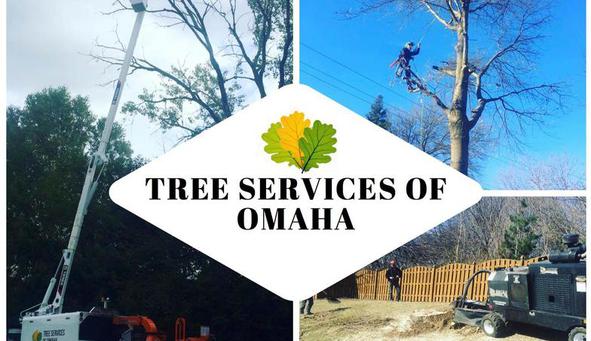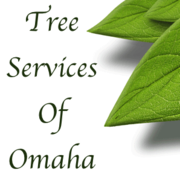Tree Services of Omaha - Dutch Elm Disease
by David Steg on 10/01/14
Symptoms
 Click on above to see enlargement.  Figure 1. (top) Tree displaying symptoms of disease, (bottom) brown annual rings of a stem. (photographs courtesy of L. Grand). |
The
progression of symptoms of Dutch elm disease in the crown depends on
how the tree was infected. If the tree was infected in the upper crown
by feeding of insects carrying the fungus, the first visible symptom is a
rapid wilting of the leaves on one or more branches in the top of the
tree. The leaves on the affected branches turn yellow and then brown,
gradually become shriveled and brittle and may be shed prematurely. Tips
of affected branches often develop a characteristic downward hook-like
curve that is a helpful aid in diagnosis. Wilted and discolored leaves
(called flags) usually become visible about mid-June and are most
evident during July and August (Figure 1). If the fungus enters the tree
through roots grafted to infected trees, the symptoms may begin in the
lower crown and the entire crown may be affected very rapidly. An
important diagnostic characteristic is the occurrence of a more or less
continuous brown ring or streaks in the outermost annual rings of
diseased branches or stems (Figure 1).
Because
symptoms of Dutch elm disease are similar to those of other diseases of
elm, diagnosis in the field is often difficult. For this reason, it is
necessary to collect symptomatic branches and submit them to a
diagnostic clinic for laboratory tests. Select branches approximately ½
inch in diameter from dying, not dead, branches and promptly send them
in a plastic bag to the Clinic in your state for testing. Check with
your local County Extension Agent for more information. A directory of
North Carolina agents can be found at http://www.ces.ncsu.edu/directory/.
Cause
Dutch elm disease is caused by the fungus Ophiostroma ulmi and is spread from tree to tree primarily by insects. In the United States, the smaller European bark beetle (Scolytus multistriatus) and the native elm bark beetle (Hylurgopinus rufipes) are the most common vectors. Adults of these insects construct galleries in or under the bark of dead or dying trees affected by the disease, and lay eggs along the sides of the galleries. After hatching, the larvae feed away from the galleries, and pupation occurs at the end of the larval tunnels (figure 2). In the meantime, fruiting bodies of the fungus are produced from the walls of the galleries. These fruiting bodies produce masses of sticky spores that adhere to the surface of the adult beetles as they exit the bark (figure 2). Immediately after exiting the bark, the adult beetles fly to healthy elms where they feed in the crotches of small twigs (smaller European bark beetle) or in the inner bark and wood of branches 2-10 inches in diameter (native elm bark beetle). It is during this feeding process that the fungus is introduced into the tree. After feeding in healthy trees, the beetles then move to weakened, dying or dead elm trees, or to logs, for breeding, and the cycle is repeated. Usually there are two broods of beetles each year. The overwintering brood emerges in early summer and is responsible for the largest number of new infections. The beetles usually do not travel more than a few hundred feet from the place of emergence to feed, but they may travel for more than 2 miles in search of proper breeding places. In some areas rate of spread is rarely more than 5 or 6 miles per year.
In
addition to insects, the fungus may be transmitted from elm to elm by
root grafts (figure 2). This is an important means of spread where elms
are growing in close proximity, such as rows of trees along streets.
    Figure 2. (left) Galleries formed by elm bark beetles; (middle left) conidia (asexual stage) of O. ulmi; (middle right) perithecia and ascospores (sexual stage); (right) root graft. (Photographs courtesy of L. Grand) |
Control
The most effective means of reducing losses from Dutch elm disease involves following a complete community-wide integrated control program. Steps 1, 2, 3 and 6 below are general recommendations applicable to all elm trees. Steps 4 and 5 should be considered only on certain highly valued elm trees.
Step 1. Sanitation. Remove all elm wood that may serve as a breeding place for insect vectors. Elm trees that are known to be infected with Dutch elm disease or infested with elm bark beetles, recently cut or broken elm branches and logs stored for fuel should be destroyed, debarked, or utilized before the emergence of the beetles in the spring. Prompt tree removal and destruction must be done on a community-, city- or county-wide basis to be effective. Cutting down a tree in one yard will do little good if the owners next door do not remove their dead trees also.
Step 2. Kill root grafts. Soil should be treated between diseased and any healthy elms within 100 feet to stop the spread of the fungus through root grafts. Immediately after a tree is diagnosed as having Dutch elm disease and 2 weeks before it is cut down, drill a series of holes approximately 1 inch in diameter, 15 inches deep, and 6 to 9 inches apart in a line between the diseased and any healthy elm trees. Mix 1 part of SMDC (Vapam) with 3 parts of water and fill each hole with the mixture to within 2 inches of the soil surface. Do not use within 20 feet of healthy trees. Soil temperature should be above 50 F at the time of application. SMDC (Vapam) must be applied by a trained applicator. A narrow trench 18 inches deep can be dug between the diseased and healthy trees as an alternative to the SMDC treatment.
Step 3. Insect Control. The sanitation methods under #1 will help reduce the number of insect vectors present. Fertilize trees to maintain them in a vigorously growing condition. Chloropyrifos (Pageant DF) has been used as a spray in some areas to control insect vectors.
Step 4. Systemic Chemical Prevention. Propiconazole (Alamo) and thiabendazole (Arbotect 20S) are registered for Dutch elm disease control. These materials can be injected into the tree trunk or flare roots for both preventative and therapeutic treatment. Preventative treatment should be made for trees that show no symptoms of the disease, and should be repeated every 2-3 years in the spring on a warm, sunny day after the leaves have expanded. Follow all label precautions. Since the treatment must be continued every 2-3 years for the life of the tree, and new injection wounds must be made each year, the advisability of this practice is questionable in North Carolina except for highly valued trees.
Step 5. Chemical Therapy. Fungicide injections, as in Step 4, have given some control of Dutch elm disease after the symptoms have appeared, provided the chemical is applied properly before the crown exhibits no more than 5% disease symptoms. If more than 5% of the crown is exhibiting symptoms, the chance of control is very slight. If the fungus has entered the trunk of the tree, or if the tree became infected through root grafts, chemical control will not be effective. Continue to monitor trees yearly and make repeated injections if symptoms of the disease reappear or continue to progress. This treatment should be considered only for highly valued trees that are otherwise healthy. Follow all label precautions. Any branches showing symptoms also must be cut out promptly 2 weeks after the injection is made. The treatment given in Step 2 should also be followed in case the disease is not controlled.
Step
6. Resistance. Only elms are susceptible to Dutch elm disease. Planting
other tree species will avoid this disease problem. Resistant hybrid
elms and some resistant clones of American elm are now available.
Consult your local nursery.



